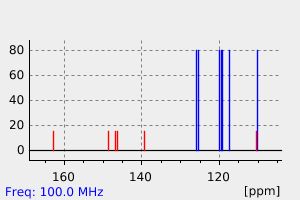2-(2,3-dihydroxylphenyl)benzoxazole | 24978-46-9
中文名称
——
中文别名
——
英文名称
2-(2,3-dihydroxylphenyl)benzoxazole
英文别名
3-(benzoxazol-2-yl)benzene-1,2-diol;3-benzooxazol-2-yl-benzene-1,2-diol;2-(2,3-Dihydroxyphenyl)-benzoxazol;3-Benzoxazol-2-ylbenzene-1,2-diol;3-(1,3-benzoxazol-2-yl)benzene-1,2-diol
CAS
24978-46-9
化学式
C13H9NO3
mdl
——
分子量
227.219
InChiKey
XJOKBCBRRZEMPJ-UHFFFAOYSA-N
BEILSTEIN
——
EINECS
——
-
物化性质
-
计算性质
-
ADMET
-
安全信息
-
SDS
-
制备方法与用途
-
上下游信息
-
文献信息
-
表征谱图
-
同类化合物
-
相关功能分类
-
相关结构分类
计算性质
-
辛醇/水分配系数(LogP):2.7
-
重原子数:17
-
可旋转键数:1
-
环数:3.0
-
sp3杂化的碳原子比例:0.0
-
拓扑面积:66.5
-
氢给体数:2
-
氢受体数:4
上下游信息
-
上游原料
中文名称 英文名称 CAS号 化学式 分子量 2-苯基苯并恶唑 2-phenylbenzoxazole 833-50-1 C13H9NO 195.221
反应信息
-
作为产物:描述:2-苯基苯并恶唑 在 葡萄糖 、 异丙基-beta-D-硫代半乳糖吡喃糖苷 Escherichia coli JM109 harboring plasmid pBS2072B 、 M9 medium 、 维生素B1 作用下, 以77%的产率得到2-(2,3-dihydroxylphenyl)benzoxazole参考文献:名称:Synthesis of vicinal diols from various arenes with a heterocyclic, amino or carboxyl group by using recombinant Escherichia coli cells expressing evolved biphenyl dioxygenase and dihydrodiol dehydrogenase genes摘要:Various aromatic molecules, in which heterocycles are linked with a phenyl or benzyl group, were converted to their respective 2,3-diols (catechols) in the benzene ring by growing cell reactions using recombinant Escherichia coli, which expressed the evolved biphenyl dioxygenase [bphA (2072)] genes and the subsequent bacterial dihydrodiol dehydrogenase (bphB) gene. These vicinal diol products showed strong in vitro inhibitory activity against the lipid peroxidation induced by free radicals and strong scavenging activity towards DPPH radicals. The vicinal diols were also synthesized from ionized monocyclic aromatics incorporating an amino or carboxyl group. (C) 2004 Elsevier Ltd. All rights reserved.DOI:10.1016/j.tet.2004.10.052
文献信息
-
Switchable and selective detection of Zn<sup>2+</sup> or Cd<sup>2+</sup> in living cells based on 3′-O-substituted arrangement of benzoxazole-derived fluorescent probes作者:Yongqian Xu、Liangliang Xiao、Shiguo Sun、Zhichao Pei、Yuxin Pei、Yi PangDOI:10.1039/c4cc02335h日期:——
Two benzoxazole-derived ESIPT fluorescent sensors
E1 andE2 show highly selective detection of Zn2+ and Cd2+, respectively, in aqueous solution and living cells. -
Methyl aryl ether cleavage in benzazole syntheses in polyphosphoric acid作者:Charles M. Orlando、J. G. Wirth、D. R. HeathDOI:10.1021/jo00834a065日期:1970.9
表征谱图
-
氢谱1HNMR
-
质谱MS
-
碳谱13CNMR
-
红外IR
-
拉曼Raman
-
峰位数据
-
峰位匹配
-
表征信息
同类化合物
(SP-4-1)-二氯双(1-苯基-1H-咪唑-κN3)-钯
(5aS,6R,9S,9aR)-5a,6,7,8,9,9a-六氢-6,11,11-三甲基-2-(2,3,4,5,6-五氟苯基)-6,9-甲基-4H-[1,2,4]三唑[3,4-c][1,4]苯并恶嗪四氟硼酸酯
(5-氨基-1,3,4-噻二唑-2-基)甲醇
齐墩果-2,12-二烯[2,3-d]异恶唑-28-酸
黄曲霉毒素H1
高效液相卡套柱
非昔硝唑
非布索坦杂质Z19
非布索坦杂质T
非布索坦杂质K
非布索坦杂质E
非布索坦杂质D
非布索坦杂质67
非布索坦杂质65
非布索坦杂质64
非布索坦杂质61
非布索坦代谢物67M-4
非布索坦代谢物67M-2
非布索坦代谢物 67M-1
非布索坦-D9
非布索坦
非唑拉明
雷非那酮-d7
雷西那德杂质2
雷西纳德杂质L
雷西纳德杂质H
雷西纳德杂质B
雷西纳德
雷西奈德杂质
阿西司特
阿莫奈韦
阿考替胺杂质9
阿米苯唑
阿米特罗13C2,15N2
阿瑞匹坦杂质
阿格列扎
阿扎司特
阿尔吡登
阿塔鲁伦中间体
阿培利司N-1
阿哌沙班杂质26
阿哌沙班杂质15
阿可替尼
阿作莫兰
阿佐塞米
镁(2+)(Z)-4'-羟基-3'-甲氧基肉桂酸酯
锌1,2-二甲基咪唑二氯化物
锌(II)(苯甲醇)(四苯基卟啉)
锌(II)(正丁醇)(四苯基卟啉)
锌(II)(异丁醇)(四苯基卟啉)







